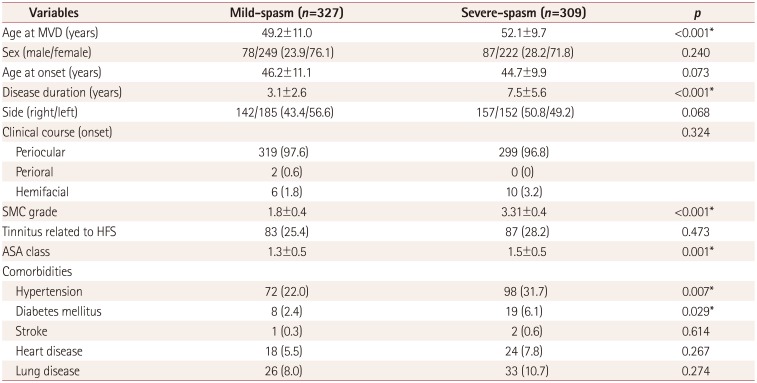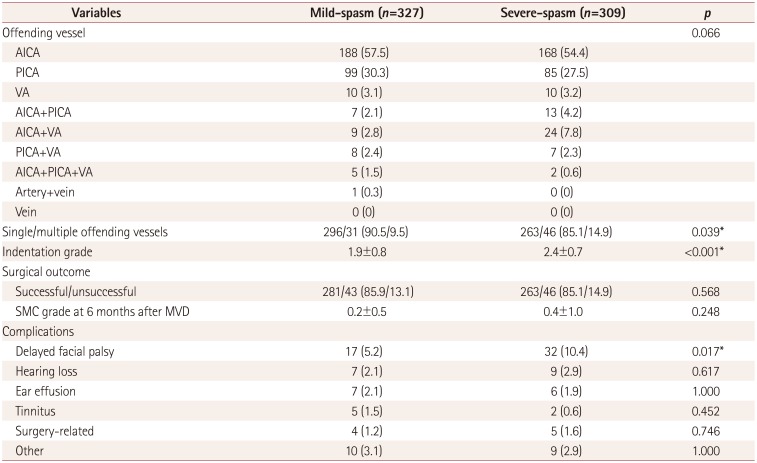1. Wang A, Jankovic J. Hemifacial spasm: clinical findings and treatment. Muscle Nerve. 1998; 21:1740–1747. PMID:
9843077.

2. Gardner WJ. Concerning the mechanism of trigeminal neuralgia and hemifacial spasm. J Neurosurg. 1962; 19:947–958. PMID:
13946557.

3. Jannetta PJ. Observations on the etiology of trigeminal neuralgia, hemifacial spasm, acoustic nerve dysfunction and glossopharyngeal neuralgia. definitive microsurgical treatment and results in 117 patients. Neurochirurgia. 1977; 20:145–154. PMID:
198692.

4. Mauriello JA Jr, Leone T, Dhillon S, Pakeman B, Mostafavi R, Yepez MC. Treatment choices of 119 patients with hemifacial spasm over 11 years. Clin Neurol Neurosurg. 1996; 98:213–216. PMID:
8884091.

5. Reimer J, Gilg K, Karow A, Esser J, Franke GH. Health-related quality of life in blepharospasm or hemifacial spasm. Acta Neurol Scand. 2005; 111:64–70. PMID:
15595940.

6. Tan EK, Fook-Chong S, Lum SY, Thumboo J. Validation of a short disease specific quality of life scale for hemifacial spasm: correlation with SF-36. J Neurol Neurosurg Psychiatry. 2005; 76:1707–1710. PMID:
16291898.

7. Heuser K, Kerty E, Eide PK, Cvancarova M, Dietrichs E. Microvascular decompression for hemifacial spasm: postoperative neurologic follow-up and evaluation of life quality. Eur J Neurol. 2007; 14:335–340. PMID:
17355557.

8. Tan EK, Fook-Chong S, Lum SY, Lim E. Botulinum toxin improves quality of life in hemifacial spasm: validation of a questionnaire (HFS-30). J Neurol Sci. 2004; 219:151–155. PMID:
15050451.

9. Jin Y, Zhao C, Su S, Zhang X, Qiu Y, Jiang J. Residual hemifacial spasm after microvascular decompression: prognostic factors with emphasis on preoperative psychological state. Neurosurg Rev. 2015; 38:567–572. PMID:
25869929.

10. Thirumala PD, Shah AC, Nikonow TN, Habeych ME, Balzer JR, Crammond DJ, et al. Microvascular decompression for hemifacial spasm: evaluating outcome prognosticators including the value of intraoperative lateral spread response monitoring and clinical characteristics in 293 patients. J Clin Neurophysiol. 2011; 28:56–66. PMID:
21221005.

11. Lv MY, Deng SL, Long XF, Liu ZL. Long-term outcome of microvascular decompression for hemifacial spasm. Br J Neurosurg. 2017; 31:322–326. PMID:
28288523.

12. Kim HR, Rhee DJ, Kong DS, Park K. Prognostic factors of hemifacial spasm after microvascular decompression. J Korean Neurosurg Soc. 2009; 45:336–340. PMID:
19609416.

13. Jo KW, Kong DS, Park K. Microvascular decompression for hemifacial spasm: long-term outcome and prognostic factors, with emphasis on delayed cure. Neurosurg Rev. 2013; 36:297–301. PMID:
22940822.

14. Lee JA, Jo KW, Kong DS, Park K. Using the new clinical grading scale for quantification of the severity of hemifacial spasm: correlations with a quality of life scale. Stereotact Funct Neurosurg. 2012; 90:16–19. PMID:
22189960.

15. Yaltho TC, Jankovic J. The many faces of hemifacial spasm: differential diagnosis of unilateral facial spasms. Mov Disord. 2011; 26:1582–1592. PMID:
21469208.

16. Lu AY, Yeung JT, Gerrard JL, Michaelides EM, Sekula RF Jr, Bulsara KR. Hemifacial spasm and neurovascular compression. Scientific-WorldJournal. 2014; 2014:349319. PMID:
25405219.

17. Doyle DJ, Garmon EH. American Society of Anesthesiologists Classification (ASA Class). Treasure Island (FL): StatPearls Publishing LLC;2017.
18. Youn J, Kwon S, Kim JS, Jeong H, Park K, Cho JW. Safety and effectiveness of microvascular decompression for the treatment of hemifacial spasm in the elderly. Eur Neurol. 2013; 70:165–171. PMID:
23921578.

19. Huh R, Han IB, Moon JY, Chang JW, Chung SS. Microvascular decompression for hemifacial spasm: analyses of operative complications in 1582 consecutive patients. Surg Neurol. 2008; 69:153–157. PMID:
18261641.

20. House JW, Brackmann DE. Facial nerve grading system. Otolaryngol Head Neck Surg. 1985; 93:146–147. PMID:
3921901.

21. Jo KW, Kim JW, Kong DS, Hong SH, Park K. The patterns and risk factors of hearing loss following microvascular decompression for hemifacial spasm. Acta Neurochir. 2011; 153:1023–1030. PMID:
21240531.

22. Chen YC, Thaler D, Nixon PD, Stern CE, Passingham RE. The functions of the medial premotor cortex. II. the timing and selection of learned movements. Exp Brain Res. 1995; 102:461–473. PMID:
7737392.
23. Park K, Hong SH, Hong SD, Cho YS, Chung WH, Ryu NG. Patterns of hearing loss after microvascular decompression for hemifacial spasm. J Neurol Neurosurg Psychiatry. 2009; 80:1165–1167. PMID:
19762909.

24. Rudzińska M, Wójcik M, Malec M, Grabska N, Szubiga M, Hartel M, et al. Factors affecting the quality of life in hemifacial spasm patients. Neurol Neurochir Pol. 2012; 46:121–129. PMID:
22581593.

25. Peeraully T, Tan SF, Fook-Chong SM, Prakash KM, Tan EK. Headache in hemifacial spasm patients. Acta Neurol Scand. 2013; 127:e24–e27. PMID:
23311349.

26. Kim KJ, Kim JM, Bae YJ, Bae HJ, Jeon B, Kim JH, et al. The association between vertebrobasilar dolichoectasia and hemifacial spasm. Parkinsonism Relat Disord. 2016; 32:54–59. PMID:
27567723.

27. Crabtree GS, Gish D, Goldberg D. Hemifacial spasm in a patient with basilar artery dolichoectasia caused by uncontrolled hypertension. J Community Hosp Intern Med Perspect. 2016; 6:32686. PMID:
27802860.

28. Leong JL, Li HH, Chan LL, Tan EK. Revisiting the link between hypertension and hemifacial spasm. Sci Rep. 2016; 6:21082. PMID:
26891766.

29. Oliveira LD, Cardoso F, Vargas AP. Hemifacial spasm and arterial hypertension. Mov Disord. 1999; 14:832–835. PMID:
10495046.

30. Rudzińska M, Wójcik-Pędziwiatr M, Malec-Litwinowicz M, Grabska N, Hartel M, Flak M, et al. Is hypertension a risk factor of hemifacial spasm? Neurol Neurochir Pol. 2016; 50:69–74. PMID:
26969561.

31. Bandyopadhyay SK, Dutta A. Hemifacial spasm complicating diabetic ketoacidosis. J Assoc Physicians India. 2005; 53:649–650. PMID:
16190139.
32. Chakrabarti S. Hemifacial spasm due to non-ketotic hyperglycemia. Int J Adv Med Health Res. 2014; 1:90–92.

33. Li S, Feng B, Xie C, You C, Wei X, Zheng X. Good surgical outcomes of hemifacial spasm patients with obvious facial nerve indentation and color change. World Neurosurg. 2016; 92:218–222. PMID:
27184901.

34. Hua Z, Da TY, Hui WX, Tingting Y, Jin Z, Yan Y, et al. Delayed facial palsy after microvascular decompression for hemifacial spasm. J Craniofac Surg. 2016; 27:781–783. PMID:
27046467.

35. Liu LX, Zhang CW, Ren PW, Xiang SW, Xu D, Xie XD, et al. Prognosis research of delayed facial palsy after microvascular decompression for hemifacial spasm. Acta Neurochir. 2016; 158:379–385. PMID:
26659255.

36. Prasad GL, Kumar V, Menon G. Delayed facial palsy after microvascular decompression: report of two cases. J Neurosci Rural Pract. 2017; 8:461–465. PMID:
28694636.

37. Furukawa K, Sakoh M, Kumon Y, Teraoka M, Ohta S, Ohue S, et al. [Delayed facial palsy after microvascular decompression for hemifacial spasm due to reactivation of varicella-zoster virus]. No Shinkei Geka. 2003; 31:899–902. PMID:
12968493.
38. Lee MH, Jee TK, Lee JA, Park K. Postoperative complications of microvascular decompression for hemifacial spasm: lessons from experience of 2040 cases. Neurosurg Rev. 2016; 39:151–158. PMID:
26382646.








 PDF
PDF ePub
ePub Citation
Citation Print
Print


 XML Download
XML Download